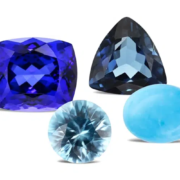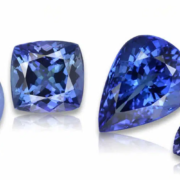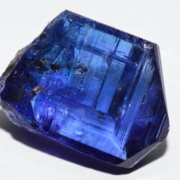Tanzanite: Properties, Uses and Virtues
Tanzanite: a stone on the rise!
Discover the geological origins, historical significance and metaphysical properties of this captivating gemstone.
Tanzanite: Table of contents
- Geological formation of Tanzanite
- Tanzanite Rough – Raw Beauty Revealed
- Sources – The Global Scope of Tanzanite
- Historical Significance of Tanzanite – Through the Ages
- Metaphysical properties of Tanzanite – Illuminating energies
- Varieties of Tanzanite
- Tanzanite Colors
- Durability and Wearability of Tanzanite
- Tanzanite Enhancements – Preserving Natural Beauty
- Synthetic Tanzanite – Nature in the Laboratory
- Tanzanite Imitations – Discerning the Genuine
- Tanzanite care – Preserving natural beauty
Geological formation of Tanzanite
Tanzanite’s captivating journey begins at the heart of the Earth’s crust, where it is formed by the metamorphic interaction of minerals under the intense heat and pressure of tectonic activity.
Tanzanite’s captivating journey begins at the heart of the Earth’s crust, where it is formed by the metamorphic interaction of minerals under the intense heat and pressure of tectonic activity.
Tanzanite Rough – Raw Beauty Revealed
Crude tanzanite crystals reveal orthorhombic prisms with striations along their faces, although tanzanite is often found as broken crystals.
Sources – The Global Scope of Tanzanite
Tanzania is the main source of tanzanite, discovered in the foothills of Mount Kilimanjaro. This captivating gemstone is a unique gift from the African continent and holds a special place in the hearts of those who appreciate its exceptional blue hues.
Historical Significance of Tanzanite – Through the Ages
The history of tanzanite is relatively recent, with its discovery dating back to the 1960s.
However, thanks to the marketing efforts of several jewellery companies, its rise to popularity has been rapid, capturing the attention of designers and gem enthusiasts the world over.
Tanzanite’s unique blue-violet hues have resonated with those seeking a distinctive and meaningful gemstone, making it a captivating December birthstone.
Metaphysical properties of Tanzanite – Illuminating energies
Tanzanite is revered for its metaphysical properties, which promote spiritual growth and heightened awareness. It is believed to stimulate the third eye chakra, promoting intuitive abilities and enlightenment. The energy of tanzanite is said to encourage mindfulness, deep meditation and connection to higher planes.
Varieties of Tanzanite
Tanzanite varies in colour, but not in variety as such. It is in itself a variety of zoïsite.
Tanzanite Colors
Although tanzanite is best known for its superb blue colour, it can come in a range of hues, from pale lavender to deep violet. These variations add depth and versatility to the gem, allowing for a variety of jewellery designs to suit different preferences.
Blue-violet is rarely natural and most reddish-brown zoïsites are heat-treated to obtain the coveted violet hues of tanzanite.
Note that this is a trichroic stone, with hues ranging from red to violet and green depending on the axis.
Durability and Wearability of Tanzanite
Tanzanite’s hardness, rated at 6.5 to 7 on the Mohs scale, makes it suitable for a variety of jewellery applications, although it is best kept in protective settings. Although tanzanite requires appropriate care to preserve its brilliance, its captivating beauty makes it a precious stone worthy of admiration and wear.
Tanzanite Enhancements – Preserving Natural Beauty
Tanzanite is commonly heat-treated to improve its colour and clarity, a practice widely accepted in the industry. This enhancement process brings out the gem’s characteristic blue-violet hues from yellow to reddish-brown zoïsites, improving its natural beauty while preserving its intrinsic characteristics.
Other improvements include a surface coating.
Synthetic Tanzanite – Nature in the Laboratory
Synthetic tanzanite has not yet been created. Assume that all the tanzanites on the market are either natural or imitations.
Tanzanite Imitations – Discerning the Genuine
Because of its popularity, tanzanite has faced imitations and treatments designed to imitate its captivating colours.
Most of the competitors are sapphires, synthetic forsterite, synthetic corundum, blue glass, iolite and spinel.
Ensuring authenticity when buying tanzanite is essential, and reputable sources can provide certification and information to differentiate genuine tanzanite from counterfeits.
Tanzanite care – Preserving natural beauty
Taking care of tanzanite jewellery guarantees its lasting beauty.
To preserve their brilliance, tanzanites need to be protected from aggressive chemicals and rapid temperature changes.
Clean the gemstone gently with mild soapy water and a soft brush, ensuring that it continues to shine for generations.
Avoid mechanical cleaning.





Leave a Reply
Want to join the discussion?Feel free to contribute!